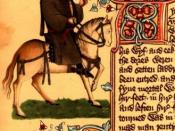"The Miller's Tale" and "The Reeve's Tale", two stories in Geoffrey Chaucer's The Canterbury Tales, are fabliaux, bawdy and comic tales that build to a ridiculous and complex climax usually hinging on some joke or trick. One parallel observed between the two stories is the unfaithfulness of the wife in marriage. Another similarity between the two stories is the theme of a husband who tries to keep control of his wife. In addition, the wife is the only one not to receive adequate retribution for her actions. One difference, however, is the meritoriousness of the recipient of the infliction of the worst physical damage.
In both stories, the wives of the miller and the reeve commit adultery.
"And thus lay Nicholas and Alison
Busy in solace and the quest of fun" (101)
Upon John the carpenter falling to sleep, Nicholas and Alison decide to betray the reeve and have sexual relations with one another.
Similarly, the miller's wife becomes guilty of fornication once the miller has fallen to sleep.
"John waited for a while, then gave a leap
And thrust himself upon this worthy wife.
It was the merriest fit in all her life,
For John went deep and thrust away like mad." (116)
Although not initially upon the intent of the miller's wife to have sex with another man, once she is engaged in it, she enjoys it thoroughly for John the clerk makes it a highly pleasurable experience. Furthermore, in "The Miller's Tale," Absalon, the epitome of a courtly lover, reaps no benefit from his courtliness except a kiss to Alison's "arse". On the contrary, the reeve's wife fornicates with Nicholas, the complete opposite of a courtly lover. This infidelity of the wives seems to imply that Chaucer does not believe that...

![[Portrait of Albert Nicholas and Rudi Blesh, Riverboat on the Hudson, N.Y., ca. July 1947] (LOC)](https://s.writework.com/uploads/5/51046/portrait-albert-nicholas-and-rudi-blesh-riverboat-hudson-n-thumb.jpg)
